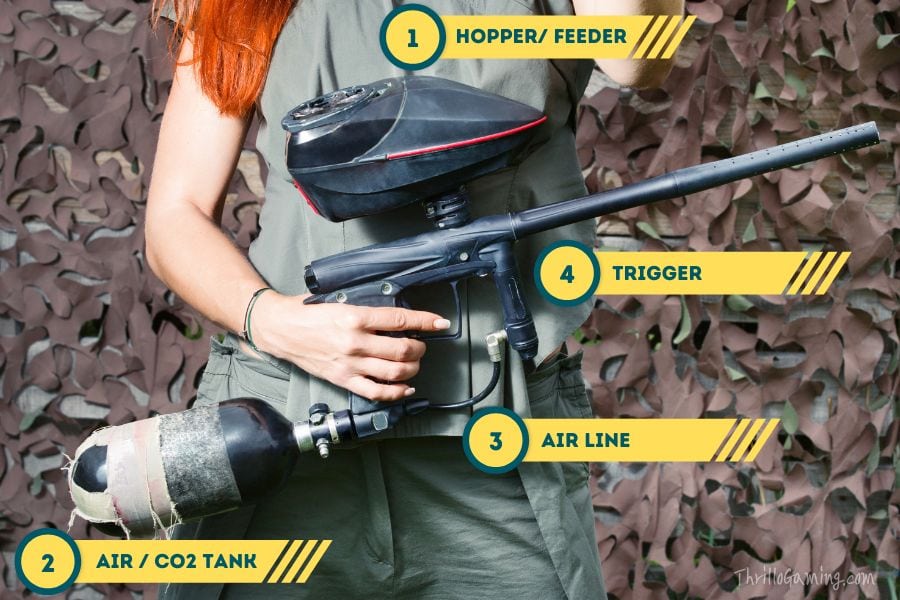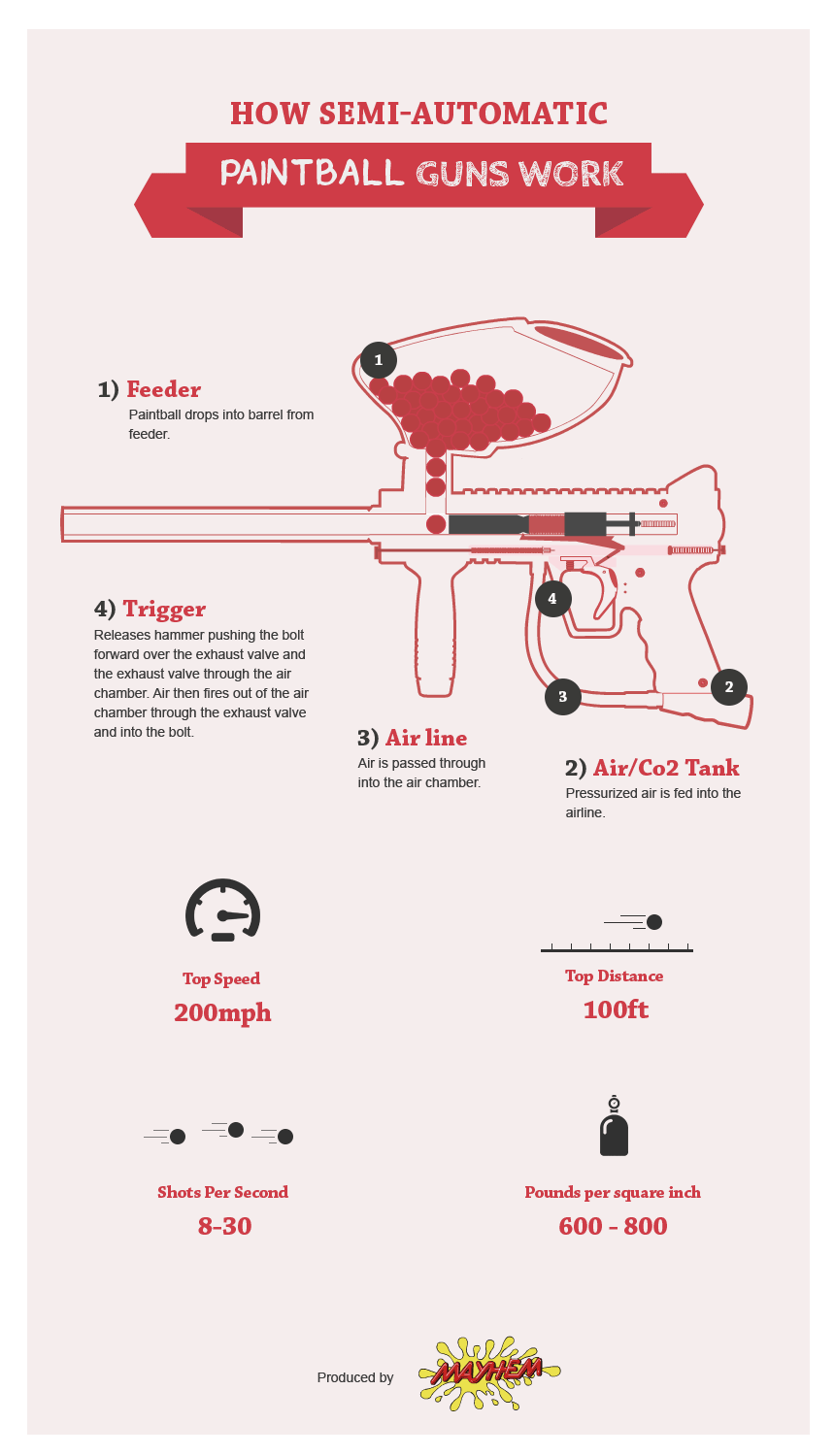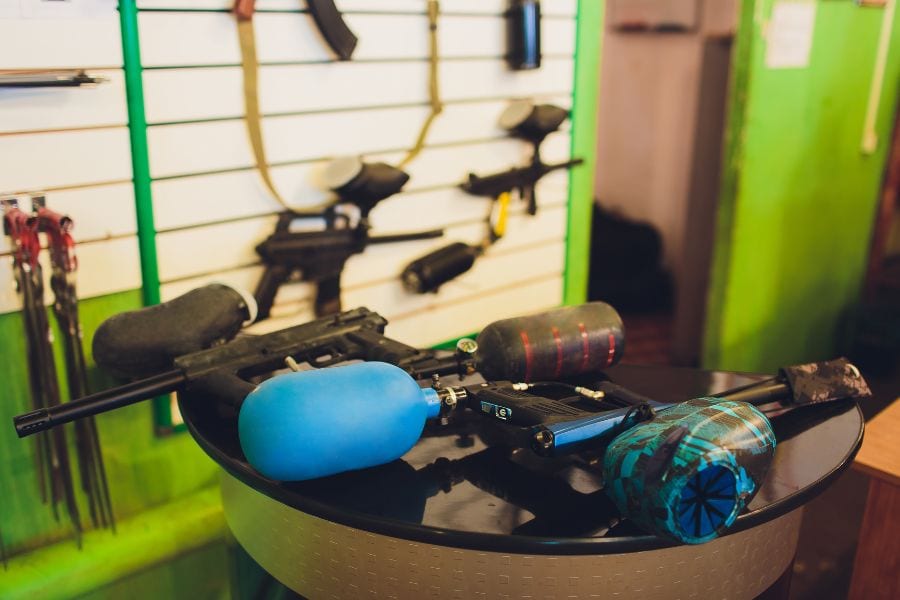The first time I got my hands on a paintball gun, I was intrigued by how it worked and how it could match my skills. How does such a small device propel paint balls at high speeds with such precision?
Obviously, a toy gun like a paintball marker wouldn’t work the same way as a real firearm. I already knew the basics, but I was curious for a better understanding. So, I got to work right away to figure out how a paintball gun works.
If you’re a beginner at paintball games, I imagine you might be in the same boat as I was back then. As always, I’m here to share my knowledge with you. Let’s dive into it and learn more about the functioning of a paintball gun.

The Basics Of Paintball Gun
Let’s start with the basics, in case paintball guns are a completely new thing to you. These guns get their name from their ammunition – small gelatin capsules called paintballs. Filled with a glob of colored liquid, the paint balls break upon impact and splatter the surface with the dye.
In other words, when shooting someone with a paintball gun, you mark them with the paint. This is why they are also known as markers among players. Those toy guns offer a great deal of fun. Think of playing multiplayer shooting games in real life, and you’ll get the picture.
Just like any other toy gun, paintball guns have different parts that collectively contribute to the working mechanism. This includes the receiver, grip frame, compressed gas tank, adapter, hopper, feed neck, barrel, trigger, etc.

How Does A Paintball Gun Work?
A paintball gun, or marker, works by using compressed gas (usually CO2 or air) to propel paintballs. A bolt controls the movement of balls from the magazine to the barrel, and a sear stays in place behind the chamber, blocking the compressed air from pushing through when not needed. When you cock the bolt and pull the trigger, it activates a series of mechanisms that result in the sear being pushed aside. This releases the compressed gas, which bursts through the air line, which, in turn, shoots out the paintball.
After that, the loader quickly replaces it with another ball to repeat the process. Simultaneously, the sear then moves back again into place, blocking the compressed gas and allowing it to build up, ensuring that the paintball gun remains ready to fire at a rate of 8-30 shots per second, depending on the specific model.
The velocity of paintballs can be adjusted by using a regulator or other available mechanism to ensure that it does not exceed a safe limit of 300 FPS to avoid injury. Also, it is advisable to refill the hopper before it gets empty and the gun fires blank shots.

Working Methods Of Different Paintball Guns
The above description of the working principle of paintball guns is a fundamental overview. Diving deeper, the method can slightly vary depending on the type of paintball gun – pump-action, bolt-action, mechanical, and electronic. Let’s find out.
Mechanical Paintball Gun: How Does It Work?
Mechanical paintball guns are the most popular markers in the market, and in my experience, they offer the best value for money. Those guns can shoot automatically in rapid succession as long as you hold down the trigger. This is very similar to semi-automatic firearms, which is why mechanical paintball guns are also known as semi-auto blasters.
Pulling the trigger of a mechanical paintball gun moves a sear catch, releasing a hammer or striker. The hammer then hits the valve and holds it open so that the compressed gas can push through and shoot out the pellet. This also causes the striker to be pushed back into the sear. Almost all mechanical markers use this mechanism and are hence known as blowback paintball guns too.
Working Of Pump-action Paintball Guns
Pump-action paintball guns require you to cock the gun and chamber the next shot by manually operating a pump. The balls are stored in a gravity-fed hopper on top of the gun. These are the oldest kind of markers and admittedly not the most convenient to use.
Like all other paintball guns, the pump-action guns also use compressed gas. When you press the trigger, it opens the valve, allowing compressed air to flow into the barrel and push out the pellet. You’ll then have to chamber the next shot before you can shoot again.
As you can see, the functioning of a pump-action paintball gun is much simpler than that of a mechanical marker.
How Does A Bolt-action Paintball Gun Work?
These paintball guns also require manual chambering but use a pneumatic bolt rather than a pump. There are different bolt-action mechanisms, although the rotating bolt is the most popular one. The overall working principle is very similar to that of a pump-action gun. You have to turn the bolt to move the next pellet into the chamber between the shots.
Bolt-action paintball guns are a bit more convenient to use than their pump-action variants. Unlike in the latter case, you don’t have to move a bolt-action gun while chambering the shot. This means you can hold and correct your aim for consecutive shots.
Electronic Paintball Guns: Working Principle
Electronic markers are exactly what you’d imagine them to be – a more powerful and battery-operated version of mechanical paintball guns. However, the chain of semi-automatic processes of an electronic pneumatic paintball gun is replaced by an electronic circuit board that controls the solenoid that moves the sear catch.
Electronic paintball guns can be further classified into three subtypes based on their valve mechanism – electronic sear trippers, spool valves, and pneumatic poppet valves.
Pressing the trigger activates a micro switch or trips a laser beam, thereby setting off the firing cycle. The cycle is much shorter than a mechanical paintball gun, which results in a quicker firing rate. Most of electronic guns still use the blowback mechanism found in the mechanical ones.
Watch this video to get a visual representation of the working method of paintball guns. Though the marker used is a Tippmann A5, it is also applicable to similar markers.
Why Is Compressed Air, CO2, Or Nitrogen Necessary For Paintball Markers?
Paintball guns need compressed air, CO2, or nitrogen to shoot the paint balls out of the barrel. To fire any projectile, there has to be a propelling force. Other toy guns, like gel blasters and Nerf guns, use a piston-spring system. The piston hits the projectile and sends it flying out of the barrel.
However, this working mechanism isn’t suitable for paintball guns, as hitting pellets with a piston would make them burst. So, compressed air, CO2, or nitrogen is an absolute necessity for them.
Recommended: What To Do With Old Paintball Tanks?

What Happens If You Run Out Of Compressed Gases?
Each time you press the trigger, the air tank of your paintball gun releases some compressed gas. You’ll notice a slump in the gun’s firing power at some point as it begins to run out of gas. But, don’t worry; the gas tank is refillable.
You can either refill the tank at home if you have a compatible air compressor or take it to a store to refill. If your paintball gun uses compressed CO2, you can also refill it at a fire extinguisher store, scuba store, or welding supply store.
Conclusion
Paintball guns are fascinating recreational gears that work by using compressed gas to shoot paintballs at high speeds. By cocking the gun and pulling the trigger, I can shoot paint balls accurately and with precision. Understanding the inner workings of a paintball gun, such as the barrel, valve tube, bolt, and sear, is crucial for all players to maintain and operate their equipment effectively.
This knowledge has helped me improve my performance on the field and enhanced my overall experience. Armed with this understanding, beginners can also maneuver their way through the game with confidence, hit their targets with precision, and have a blast while doing it.

